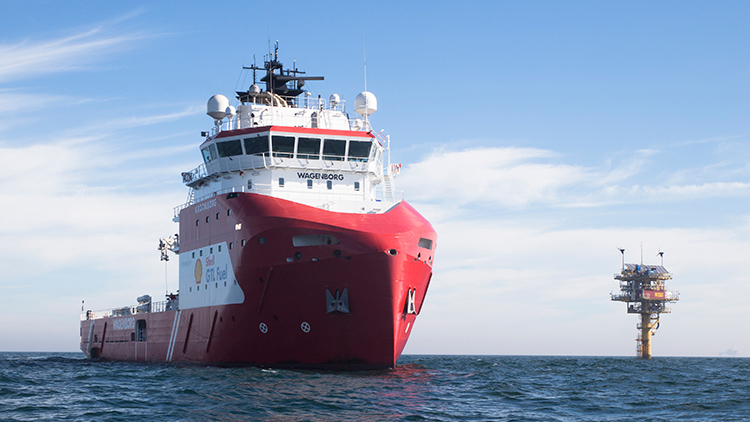Natural gas
Natural gas – the cleanest-burning hydrocarbon – comprises about half of Shell’s total production.

Kroonborg is the first offshore vessel in the world to sail on GTL fuel, a liquid fuel made of natural gas with less emissions than conventional fuels for vessels.
Natural gas provides a readily available solution to meeting rising global demand for energy with fewer emissions if used instead of coal for power generation. There are enough recoverable natural gas resources to last more than 220 years at current levels of consumption, according to the International Energy Agency. Natural gas can be transported by pipeline or in liquid form to countries in need of energy. It is also one of the few energy sources that can be used economically across most energy applications – from electricity to heating to transport fuels – and its uses are diversifying, as an alternative to diesel in trucks, heavy fuel oil in transport and oil for lubricants. As such, Shell expects it to play an increasingly prominent role in the future energy mix, both in its own right and as a partner for renewables.
Lower emissions
Natural gas produces around half the greenhouse gas (GHG) emissions of coal when burnt to generate electricity. This includes methane emissions.
Using natural gas instead of coal in power generation will also significantly improve air quality. Compared to coal-fired plants, modern natural gas plants emit less than one-tenth of sulphur oxides, nitrogen oxides, particulates and heavy metals that impact hundreds of millions of people all over the world, especially in Asia.
Natural gas can also be used in combination with carbon capture and storage (CCS) to further reduce GHG emissions. CCS can remove up to 90% of CO2 emissions from power plants, according to the UN Intergovernmental Panel on Climate Change.
Pearl gas-to-liquids project
The Pearl gas-to-liquids (GTL) project − 80 kilometres north of Doha, Qatar – is the world’s largest plant to turn natural gas into fuels and lubricants (Shell interest 100%).
The plant relies on a heavy paraffin synthesis (HPS) catalyst. It accelerates the reaction that converts synthesis gas, a mixture of hydrogen and carbon monoxide, into hydrocarbons that can be broken down into shorter chain molecules and then turned into finished GTL products. These include paraffin for detergents and kerosene for blending into aviation fuel.
In 2016, Shell reduced heavy paraffin synthesis off-gas operational flaring at the plant to zero by using the gas as a fuel to power the plant. As a result, less energy is used to make the same products, which results in reduced CO2 intensity.
In addition, the flared gas was used to generate electricity, which was exported to Doha-based Kahramaa, Qatar’s national Electricity and Water Company.
A partner for renewables
Natural gas is flexible and offers significant advantages as a partner with renewables, which will be essential in a transition to a low-carbon future.
Using gas as a partner ensures steady power supplies when the sun does not shine or the wind does not blow. Modern gas-fired power plants also take less than a third of the time a coal plant needs to ramp up to full operation.
Increasing use of renewables will be vital in the energy transition. However, renewables are mostly used to produce electricity which due to the high temperature needed in the manufacture of materials such as iron, steel and cement, will struggle to replace oil and gas on a practical scale. This means gas will complement renewables by continuing to play a core role in industry and construction. Our New Energies business is looking at how new technologies could work more effectively together, for example, combining wind and solar power with gas.
China’s future energy mix
Since 2011, Shell has worked closely with the Chinese government’s Development Research Centre (DRC) of the State Council on the country's medium- to long-term energy development strategy. The ongoing collaboration has identified the key energy challenges facing the country and suggested detailed, practical solutions.
The second phase of the collaboration examined the important role natural gas can play in helping China diversify its energy mix, boost economic development, improve air quality, and help meet China’s Intended Nationally Determined Contribution for reducing carbon emissions.
In 2016, Shell and the DRC presented the outcomes from Phase 2 at the China Development Forum. Phase 3 focuses on the future development of China’s energy system to help the country transition to a lower-carbon economy.
